#iamayoungdancer
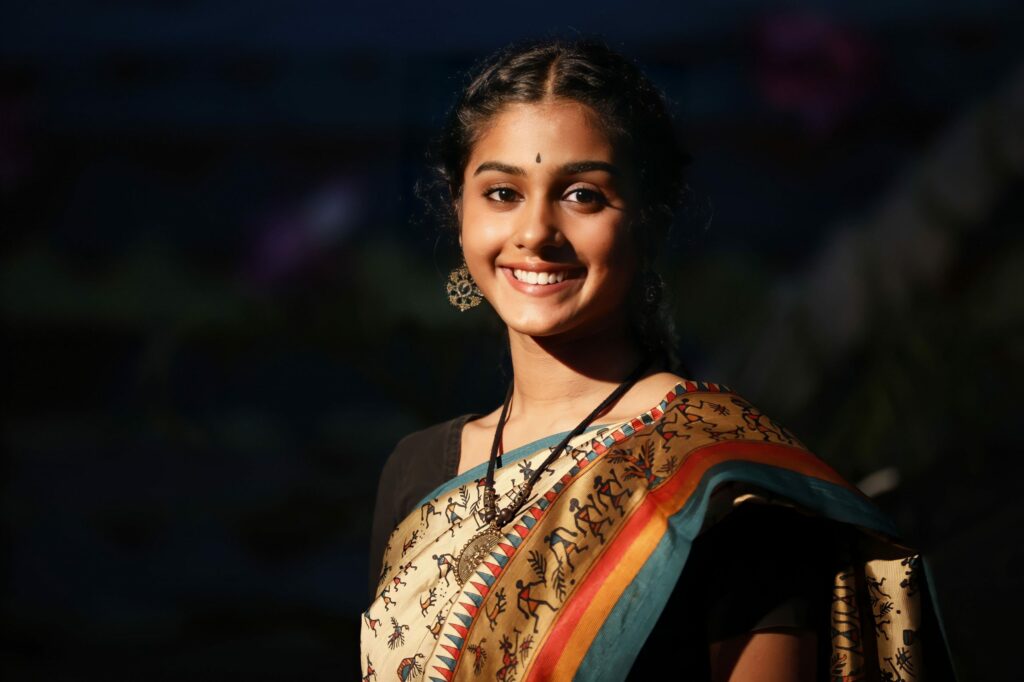
Vaishnavi Srinivasan and Shreya Murthy, get together to discuss their current state-of-mind and concerns that pertain to the world of dance and dancers In this edition of Aavartana, we decided to connect Vaishnavi Srinivasan (from Chennai) with Shreya Murthy (from Singapore) with each other, and let them have a candid conversation. Vaishnavi is a disciple of Roja Kannan and Shreya, who had her initial training at The Singapore Fine Arts Society, currently trains under Priyadarshini Govind in Chennai. When they met online – at the time we had this conversation, Shreya happened to be in Singapore – the two young dancers launched into a conversation, instantly, catching up with where they are in the now, segueing seamlessly to discuss concerns, and challenges that they contend with in the context of the world of dance. The dancers shared their experiences on how they juggled their time and energy between academics and learning dance and also discussed the possibility of taking a break from books and work to pursue dance full-time. Clearly, the duo seems like they are in a happy place, with dance occupying a significant chunk in their lives, than before. Shreya acknowledged the fact that moving base to Chennai has opened up her perspectives and possibilities in terms of dance. “Being constantly in an environment that gives you opportunities to watch performances, every other day, and to be able to think about dance constantly and almost be wrapped in that feeling is a new experience and one that’s truly enriching,” she said. Vaishnavi agreed with Shreya and together, the dancers discussed the possibility of continuing to dance, full-time or go back to academics. It’s obvious both of them are passionate about academics but nothing at the cost of dance. Amen to that! Next up, the dancers talked about how dance is evolving with the younger, more modern generation. They felt encouraged to see a variety of new ideas and subjects being presented in performances alongside neo mudras that are emerging to show modern technology. While love and pining are represented with scenarios from the modern world, they acknowledged that it would take a while for it all to gain acceptance in the dance world. They finally came to the conclusion that everything is possible if one is conscious of their tradition but tweaking it just a little to make it relevant to the world that we live in. The dancers then moved on to one of the eternal favorite topic of dancers – online vs offline classes and mediums of learning. Shreya talked about the potential of the online medium and how it has given an opportunity to dancers all around the globe to participate in workshops, view conferences and performances happening in Chennai. Vaishnavi said, “Online classes are great, when we have no choice.” She conceded that she learnt many new pieces and performed them too and was glued to her Zoom screen, every day during the years of the lockdown, but honestly, her memory of the items learnt online, she said was hazy and required constant revision, in comparison to the pieces she learnt, in person in a class environment. The dancers finally concluded with the discussion of their favorite performance in the recently concluded December Music and Dance season. Curious to know what they said? Watch this video!
Books Banter
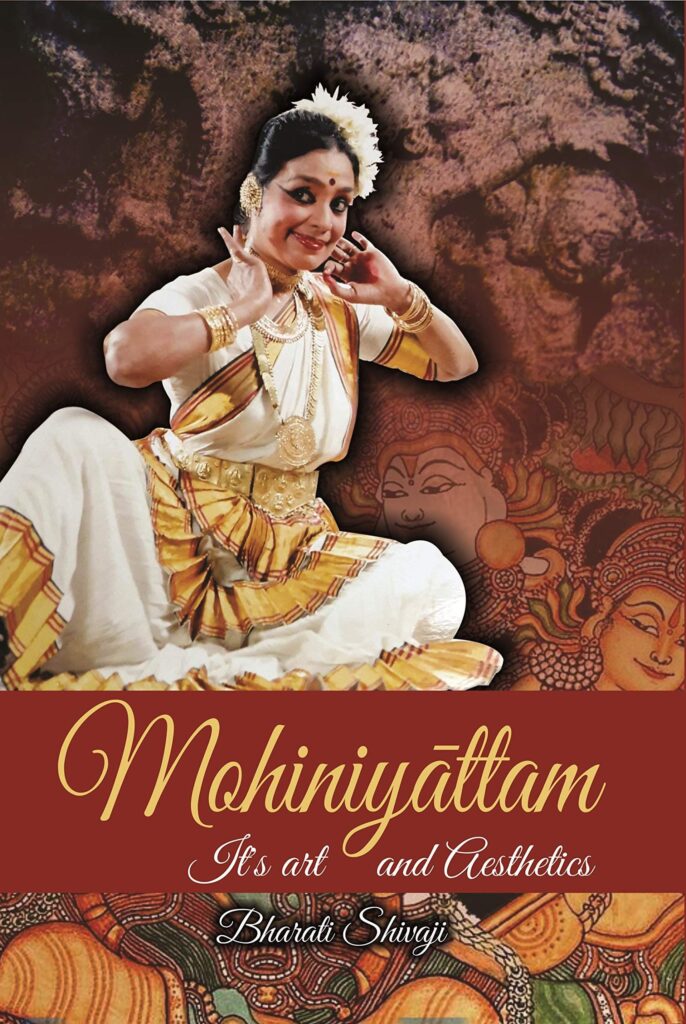
A Life in Mohiniyattam Mohiniyattam exponent, writer and author, Bharati Shivaji on her book, Mohiniyattam: Its Art and Aesthetics, an in-depth conversation about Mohiniyattam and how it has influenced her life Can you start off by letting us into the genesis of the book, Mohiniyattam: Its Art and Aesthetics? The genesis of the book is tied to my multi-dimensional, intimate and exploratory journey with the art of Mohiniyattam, which continues to be an integral part of my being and identity. It has been a living experience of decades, which started by finding myself being entrusted with the task of re-structuring and evolving a beautiful art form and which went on to enrich my life in a multitude of ways including people, places and experiences that have come with it. Each contributed to and left an indelible mark on my life journey with this uniquely graceful art form. It needed a unique identity, and a major part of my life has been spent on creating one. I feel we both (the dance form and I) symbiotically grew together. There have been dream-like learnings and possibilities of exploration for me. The book is a natural culmination of collating and sharing this journey of love, learnings and growth with the readers. What, according to you, is the hallmark of the aesthetics of Mohiniyattam and how have you managed to capture the essence of it in the book? I tried to understand Mohiniyattam in relation to its ambient cultural scape – literary, sculptural and other native arts and traditions. It is very possible for each to influence the other and in the case of Mohiniyattam too, I saw connections. For example, some sculptures seemed to echo the Lasya mood of Mohiniyattam. No art is immune from surrounding influences. That said, I do believe that every dance form must develop its distinct identity, spirit and flavour – an aesthetic framework it can call its own. It shouldn’t be overly influenced by or restrict itself to necessarily following formats set by other styles. Initially, Mohiniyattam resembled Bharatanatyam a lot in its format. To me, the hallmark of the aesthetics of Mohiniyattam has been to have the dance form develop its unique, distinct identity, while being enriched and embellished by the rich artistic soil of Kerala. This has been the essence of my journey and this is what I have tried to express through my book. Performing Mohiniyattam is one thing; writing about it, quite another. What was the process of writing this book like and what was the rigour that went into writing it? I am more of a performer than a writer. For a performing artiste, I believe nothing speaks more than the performance itself. So, my primary focus and approach has been to work extensively on choreographies and exposition, rather than literary practice. I did study them though as part of my deep work with Mohiniyattam. Over several years, I have spent a great deal of effort and time in exploring the musical traditions, ragas and tala systems of Kerala and the surrounding ethos to build a musical and performance repertoire suitable for the mood of Mohiniyattam and present it with its own rich identity and vocabulary, visual and musical. Group choreographies and dance dramas were introduced too, exploring a gamut of themes (historical as well as contemporary) for the first time. This greatly helped popularize it to a much larger audience, including international. The process of writing this book was to capture the multi-faceted growth and explorations as they have happened over the years and the underlying thought process and efforts entailed therein. The book talks about your thorough research and meticulous approach to the revival of Mohiniyattam. Can you throw more light on that? Would you say that as a researcher, you continue to do whatever it takes to keep this form fresh and agile and relevant to the world that we live in? Re-structuring and evolving the art form has required extensive understanding and exploration of its past and present in context of the surrounding regional ambience, their impact, synergies and influences (not all necessarily serving growth of the dance style). All this, while working towards carving a distinct identity for Mohinyattam to stand on its own in the galaxy of classical styles, has involved patient and meticulous research and a multi-disciplinary approach. Theatre, music, other classical and folk art forms, sculpture, literary content, etc, were all needed to be deeply observed in the process. Kavalam Narayana Panniker, the great Indian dramatist, theatre director and poet, played a monumental role in initiating and introducing me to many aspects. He greatly enabled my journey, approach and understanding, and initially even composed a set of items reflecting the regional flavour. Coming to the second part of the question – yes; my continuing work and explorations speaks to that, I think. Would you say the book is also a personal take on the elements that were involved in reconstructing Mohiniyattam and how you went about doing that? Given the length and depth of this journey I have experienced with Mohiniyattam and all that I have shared with you and in the book, I would think so. As a practitioner of Bharatanatyam and Odissi in your early years, you took it as your life mission to revive Mohiniyattam. How has this form influenced/ transformed your life? I don’t consider it amiss to say that I am what I am today because of the dance form I have been associated with and to which I have willingly given a large part of my life. It forms a lasting and inextricable part of me, my life philosophy, thinking, practices and choices. We are intimately connected at a much deeper level and I am ever so happy for it. Why is documenting art forms as books crucial for a future generation? Documenting art forms allows for them to not just cater to the viewing audience but also for readership, study and research. Today, dance is taught as
COVER STORY
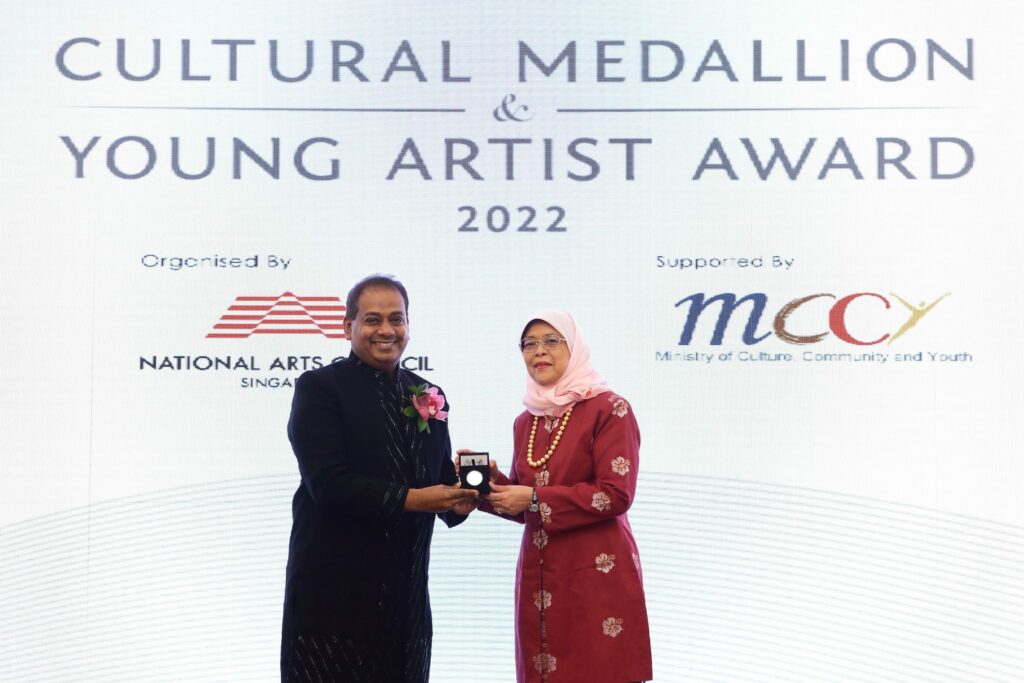
Master Weaver of Magic Raising a toast to Aravinth Kumarasamy, Artistic Director of Apsaras Arts, as he receives one of the most prestigious accolades for arts practitioners in Singapore – the Cultural Medallion… In the first week of December, Apsaras Arts Artistic Director Aravinth Kumarasamy, the man who needs no introduction to the Indian performing arts world, who wears many hats, multi-talented and multi-tasker, who believes god is in the detail and whose singular commitment to dance and to the world of the arts has resulted in a collective upliftment of the creation, production and expression of the arts in terms of ideas, innovation, form, expression – raising the creative bar of dance across the world – was conferred Singapore’s prestigious Cultural Medallion for 2022 in a stately ceremony held at the Istana, the official residence of the President of Singapore. From a recognition perspective, the Cultural Medallion – instituted in 1979 to recognise individuals whose artistic excellence, contribution and commitment to the arts has enriched and distinguished Singapore’s arts and cultural landscape – is unarguably the pinnacle accolade for arts practitioners in Singapore. What makes receiving this award just extra special is the fact that more than 30 years ago, Apsaras Arts’ co-founder Smt Neila Sathyalingam, hailing from Sri Lanka, was conferred the same honour. Neila Maami, as she was fondly known in the world of the arts, continues to be celebrated for her commitment to building Apsaras into a premier dance academy for classical Indian dance form Bharatanatyam, for cross-cultural works with Chinese and Malay dance forms and for showcasing Singapore’s multicultural personality around the world. Hailing from Sri Lanka, in 1987, as a 21-year-old, Aravinth came to Singapore to pursue his dreams. Two decades later, Aravinth was hand-picked by Neila Maami to carry forward the rich legacy of Apsaras Arts that she had so fondly built. At that time, Aravinth was neck deep in the corporate world – managing a tech start-up with international employees across 15 countries. Aravinth took a massive pay cut and committed himself to the arts, to further realise Neila Maami’s vision. For over three decades now, Aravinth has creatively, with a sense of commitment and conviction, envisaged and nurtured this art form with his imagination and ingenuity. His artistic philosophy stems from his pursuit to enable the Indian classical dance form Bharatanatyam, predominantly a solo art form, to transform into a fine and compelling ensemble-centric expression. His dream and desire to create, nourish and nurture a repertory company, a one-of-its-kind in Singapore and arguably across the world, in the space of Bharatanatyam. As a Singapore brand for Indian classical dance ensemble work, inspired by South East Asian narratives, raises a toast to the potential and the possibilities of Bharatanatyam, presented at international festivals and venues, flying the Singapore flag high. Much like the eclectic nature of his creations – to date, he has created and directed more than 35 original productions – that are diverse in form and content, Aravinth is a storehouse of many identities that inspire and influence each other. As an artiste par excellence himself, he is conscious of tradition but also cognizant of the dynamics of a rapidly changing global dynamics, where innovation and technology have vital roles to play. During the pandemic, Aravinth imagined and produced two digital CGI based one-of-a-kind dance films – SITA and AMARA – that pushed the creative envelope and have pioneered a way for a new possibility for the world of dance in exploring the digital space. Apsaras Arts’ latest production is Arisi: Rice that premiered in December at the Esplanade in Singapore, this mammoth production – stunningly visual – is an ode to rice, and in terms of expression, is collaborative in form and spirit. Featuring traditional Balinese dancers and Singapore Chinese Orchestra musicians alongside Bharatanatyam dancers and Carnatic musicians, the work is a visual documentary on the history, heritage and narratives of rice and its traditions from across the world. With a 360 degree vision for brand Apsaras Arts, Aravinth has championed industry development, and successfully curated and convened Indian Performing Arts Convention (IPAC) annually in Singapore since 2012 and in Australia since 2021. He is the proud recipient of several awards including Singapore’s “Young Artiste Award” by NAC (1999), “Bharata Kala Mani” (Apsaras Arts 2000), “Aryabhata” (India 2016), MCCY Award (2017), “Kala Ratna” (Singapore Indian Fine Arts Society 2019), “Natya Kala Upasana” (Bhaskar’s Arts Academy 2019) to list a few. Under his leadership, Apsaras Arts is possibly the most internationally travelled dance company in Singapore, regularly touring and presenting sell-out shows of original works in France, the UK, Australia, Malaysia, India and Sri Lanka. Apsaras Arts dancers and musicians have toured to more than 40 countries, collaborating with leading dance companies, legendary dancers, choreographers, composers and presenters from the international Indian dance fraternity. “I have been blessed to work with many young creative minds at Apsaras Arts, and this recognition will inspire our team to strive towards our vision for excellence. I hope our collaborators, partners and audiences will support this younger generation of Singaporean artists to pursue their passion in the arts, making Singapore stand proud on the global stage,” says Aravinth. Aravinth Kumaraswamy also received the Kala Seva Bharathi award from Bharat Kalachar as part of their 34th Margazhi Mahotsav. This award was conferred to him on December 16, 2022 in Chennai, along with other artistes like Vani Jairam, Embar Kannan and Revathi Ramachandran.
In Sights
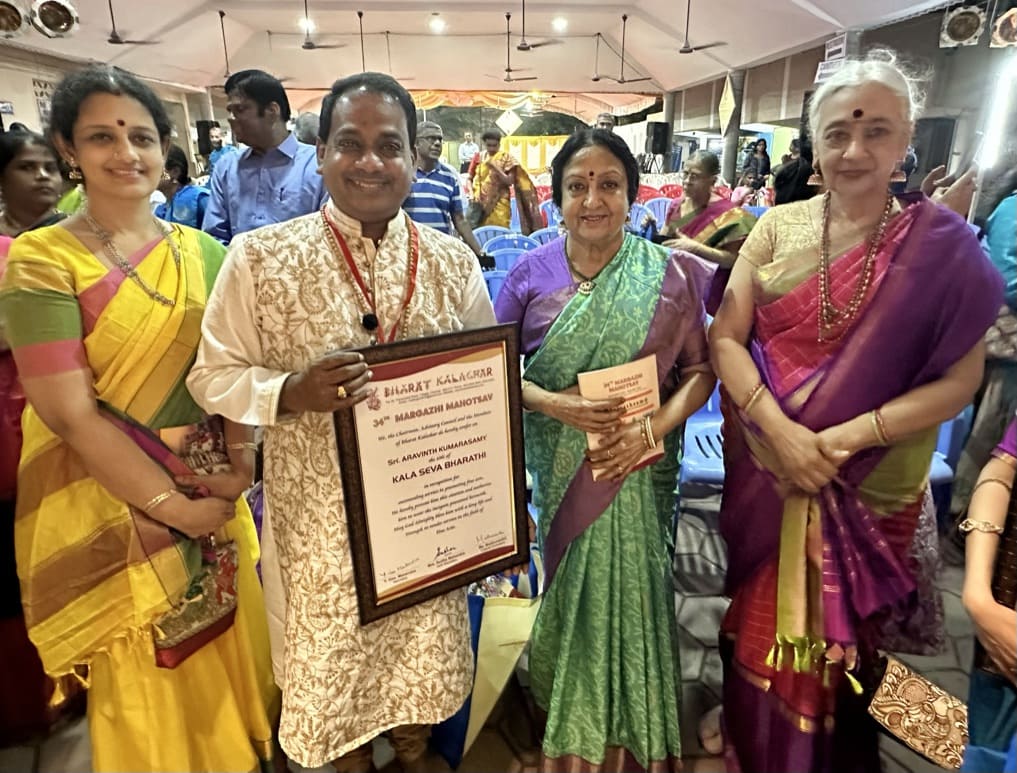
Marching into a New Year be like… It’s pouring performances, conferences and talks. Read this column for insights into what’s brewing at Apsaras Arts, recently… Apsaras Arts Dance Company was in Chennai during December 2022 – January 2023 attending the Margazhi season of music and dance, conference and performances. As part of our ongoing collaboration with the Sruti Foundation, Apsaras Arts presented the 2022 edition of Nritya Samrachana on Thillanas by Dr Sriram Parasuram and Priyadarsini Govind on two separate days – one on the musicality of the composition and the other on the the dance aspects of Thillana. Dr Sriram covered many aspects of the musical structure of the Thillana and its evolution across the decades and spoke about the various composers. He also shared many aspects of the Tarana in Hindustani music, all the while demonstrating several Thillanas and Taranas. Priyadarsini Govind shared various structures of the dance compositions of the Thillana in Bharatanatyam, demonstrated by two of her students, Apoorva Jayaraman and Shweta Prachande. She also shared video clips of Thillanas performed by legendary dancers including Kumari Kamala, both on stage and on the silver screen. The next highlight was a talk on the making of ARISI: Rice at the C.P Ramaswami Iyer Foundation in Chennai presented by Dr Nanditha Krishna. The event featured the core team – Aravinth Kumarasamy (Artistic Director), Sai Shravanam (Music Director, Music Arranger and Sound Designer) and Mohanapriyan Thavarajah (Choreographer, Costume Designer and Principal Dancer) who shared various aspects of ARISI:Rice. The event was well attended by a large gathering of leading dancers-choreographers, musicians, scholars and arts lovers. The company was featured in two leading festivals in Chennai, and had the opportunity to present two iconic repertoire productions – AMARA (at Vani Mahal) and NIRMANIKA (at the Madras Music Academy). Both these performances were well-received by audiences gathered in Chennai from across India and from other international cities around the world. More details in the Travel Diaries section. Upon our return to Singapore in mid January 2023, the Company had several performances including the annual Natarajar Anjali on the auspicious day of Thai Pusam and a performance for the annual Independence Day celebration of Sri Lanka at the High Commission in Singapore. The company mourned the passing on of legendary artiste, Lakshmi Viswanathan and held a memorial event for her at AVAI (at Apsaras Arts) that was attended by the arts fraternity of Singapore. Artists and rasikas from across organizations in Singapore were there to pay tribute to this legendary artiste who was very close to the Apsaras Arts family. Many long-time friends and long-term collaborators of Lakshmi Viswanathan from Singapore spoke at the event sharing their experiences of her, her art, and her remarkable personality. The speakers included Priyalatha Arun, Aravinth Kumarasamy, Akila Iyengar, Shantha Ratii, Lalitha Subramony, as well as Priyadarsini Govind and Rama Vaidyanathan who sent their messages online. Excerpts from Lakshmi Viswanathan’s performances in Singapore over the past 40 years were shared at the gathering. In February, the Company travels to Sri Lanka for the screening of the dance film, SITA, inspired by the paintings of Raja Ravi Varma, that will unfold at the Lionel Wendt Arts Centre in Colombo and will include a talk by Aravinth Kumarasamy on the work and its making.
Point of View
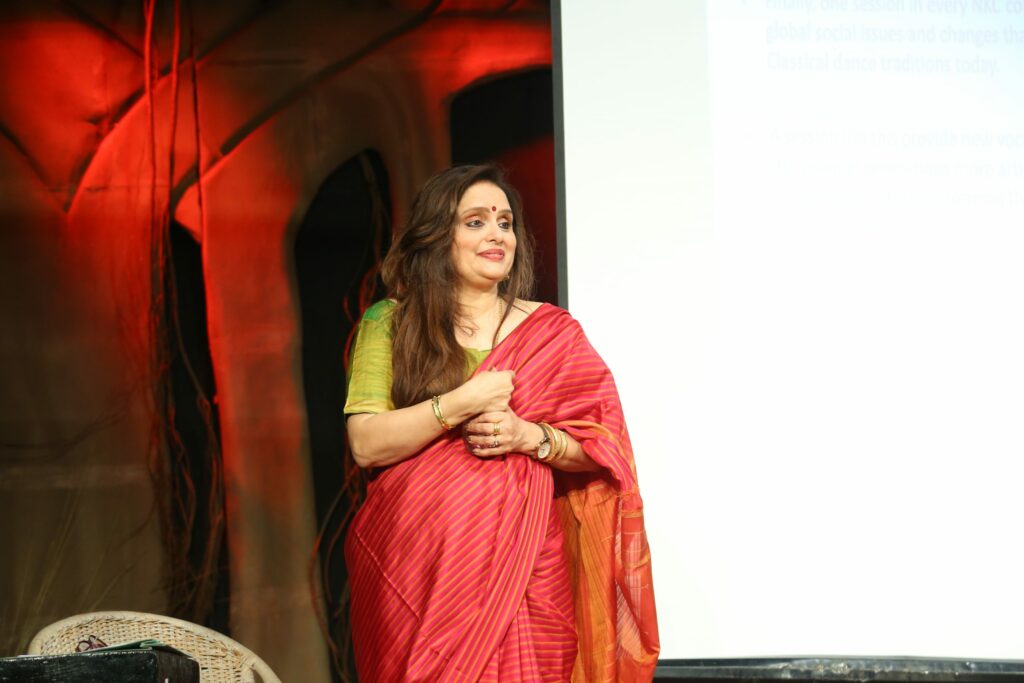
A Roots Perspective As part of the Natya Kala Conference NKC 2022, Dr Avanthi Meduri, spoke about the Bharatanatyam trees of T Balasaraswati and Rukmini Devi. Here’s an excerpt of her talk on these roots/routes In 2019, Rama Vaidyanathan rang me and asked if I would like to speak about the transnational legacies of Balasaraswati and Rukmini Devi. Rama explained that the younger generation know very little about these legendary pioneers and a lecture focussed on these women pioneers would be useful to them. She also requested that I speak in my role as an ‘academic’ and bring international discussions about Indian classical dance into the NKC forum with a view to generate inclusive debate and discussion. Since I had been given a brief, I followed through and spoke – at the Natya Kala Conference 2022 in December – as an academic who has researched the modern, colonial, national, diasporic, and global history of Bharatnatyam in the three countries of India US and UK, where I have lived and worked in the last two decades. The legendary T Balasaraswati and Rukmini Devi, were born into what is known as the greatest generation, which is the Western demographic term for a cohort of people born between 1900-1924. In the 1930s and 1950s, the two dance pioneers constituted a roots-based cultural history and aesthetic pedagogy for 20th century Bharatanatyam that was grounded in Indian tradition, and spirituality. They gave this as a historical gift to five generations of dance students who learned Bharatantayam in the Silent Generation also known as Traditionalist Generation (1928-1945), the Baby Boomers Generation (1946-1964), Generation X (1960-1970s) the Millennial Generation (1981-1996) and Generation Z (1996-2022). Constituted self -consciously within the ideological worldview of Indian cultural nationalism in the 1930s, the roots approach manifests itself as a foundational paradigm for the classical arts of India and has been used creatively by five generations of dancers, dance teachers, and scholars in India and abroad. It is this transhistorical paradigm that was renewed in Natya Kala Conference’s (an annual dance conference of the Krishna Gana Sabha) 40th anniversary celebrations in radically innovative ways over five days in the last week of December. A roots perspective is evolutionary in orientation and traces cultural continuities between historical pasts and contemporary presents. The approach looks backwards to cultural pasts, ancient traditions, literature, rituals and aesthetic texts to describe and analyse contemporary Bharatanatyam. Cultural ancestry, lineage, tradition, heritage, authenticity and cultural continuities are hallmark features of the roots-perspective. Bala developed her roots-based approach as an insider to devadasi traditions and focused on tradition, spirituality and the hereditary musical traditions of her family. Rukmini Devi developed her roots-perspective as a Brahmin outsider to devadasi dance traditions. Unlike Bala, Rukmini Devi did not inherit the dance tradition, but she laboured to possess the tradition by learning Bharatanatyam traditionally with doyens Meenaskshi Sundaram Pillai and Gowri Amma and also by associating Bharatanatyam with the galaxy of hereditary nattuvanars and music gurus that she gathered in Kalakshetra. Together and individually, both Bala and Rukmini Devi created two Bharatanatyam banyan trees which came to be known as the Balasaraswati and Kalakshetra styles of Bharatanatyam. Unsurprisingly, the dancers downplayed the stylistic differences in their modern recreations and maintained that their dance styles were continuous with and like the traditional Tanjore style represented by doyens Meenakshi Sundaram and Kandappa Pillai respectively. By not focusing on their own innovations, both Bala and Rukmini Devi articulated two very different roots- based history and aesthetic pedagogies for 20th century Bharatanatyam. In this paper, I integrated the roots’ paradigm, with travel routes and the travelling history of Bharatanatyam. I showed how the branches from the Bharatanatyam banyan trees that Bala and Rukmini Devi nurtured within the institutional context of MMA and Kalakshetra extended out of the remit of the institutions, entangled with branches from other Bharatanatyam trees founded in India and abroad in the period from the 1930s down to the present. The spreading branches, forged through travelling student communities, created a global, social structure and system for the widespread dispersal of Bharatnatyam both within India and the world at large. It is not surprising that, it is only after the demise of the dance pioneers in the 1980s that scholars working in India, US and UK were able to articulate a modern, revisionary socio-cultural history for twentieth century Bharatanatyam. Interestingly, this revisionary history was articulated by focusing on the transnational legacies of Bala and Rukmini Devi. In this lecture, I described how this global modern dance history was articulated around Bala, Rukmini Devi and devadasi women in the 1980s and 1990s and discussed the new challenges and opportunities opened up by this new field of dance studies in India and the world at large. I believe that we need to engage seriously with this transnational history, which is inscribed in a thirty-year history, because it is part of the living, practicing history of twentieth and 21st century Bharatanatyam. Millennial generation dance students need to know this modern, global dance history if they wish to pursue Indian dance studies either in India, US, Canada, UK, Australia or the world at large. In conclusion, some questions… Is Bharatanatyam an appropriated tradition? When did this appropriation occur, in the 1920s, 1930s, 1940s, 1950s, 1980s, or 1990s? Is Bharatanatyam a Sanskritized Brahmin tradition today? Have the Tamil roots of Bharatanatyam been invisibilized by the foregrounding of the Natyasastra historiography? What is the provenance of caste in the 20th and 21st century revival? Can caste be isolated as a single-issue or must it be seen dialogically in relation to class and gender? Should the cultural policy for Bharatanatyam and Indian classical dance be updated to reflect the changing aspirations of new generations of classical dancers wishing to make dance a profession and career both in India and abroad? I put forward these questions in the NKC platform in the hope that new generation dancers, dance teachers, academics, and scholars will engage these by taking seriously the social history of
Portrait
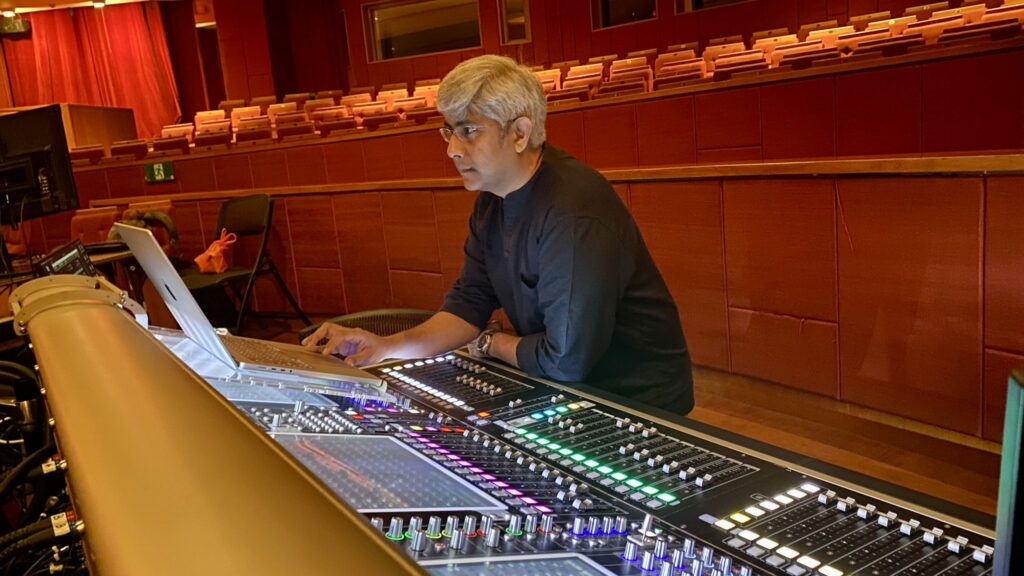
“My life is sound… I breathe sound, I walk sound, I live sound,” says Sai Shravanam, Music Director, Music Arranger and Sound Engineer, even as he shared special moments from his journey with Apsaras Arts, over the years Sai ji, you have been associated with Apsaras Arts for so many years now. Can you share with us what have been the key highlights of this association? To me, it was always Aravinth Kumaraswamy and not Apsaras Arts. Because I have always interacted with Aravinth and not with any of the founders or other members of Apsaras Arts. All I know is AK, Aravinth Kumaraswamy. I have also seen him as the principal person there, and Apsaras Arts is such a part of him. To me, he is an extraordinary visionary. I think of him as a silent worker, low profile but full of high spirits. The way he handles everything for Apsaras Arts will make you feel that Apsaras Arts is Aravinth Kumaraswamy and Aravinth Kumaraswamy is Apsaras Arts. Honestly, I am not able to separate the organisation and an entity. But what I have known from Aravinth about Apsaras Arts is that he shared an incredible love for Neila Sathyalimgam Maami, the founder of Apsaras Arts, and every instance he keeps referring to her. Unfortunately, I have interacted with her only once. As a company, what I love the most about Apsaras Arts is that it is more than a mere company, it is a family. From day one of my association with Apsaras Arts, everyone there has been so warm and friendly, treating you like a member of the family and at no point as a client who works for a producer. That feeling, I must admit, is very beautiful. There is a great sense of belonging here. As a result, creating work for/with Apsaras Arts over the years has always been about the joy of creating whatever I’d like to create; it has been a very creatively fulfilling platform for me, personally and I think the person who enables it all is Aravinth Kumaraswamy. As a company, the spirit of Apsaras Arts is inherently collaborative. Can you share an experience from your years of working with them that demonstrates this idea of collaboration? Trust is a very important part of any collaboration. I do not believe in collaborations that happen because one is knowledgeable in the arts. Collaborations happen because of the amalgamation of heart and the arts. This is very important. I see Aravinth as a catalyst, in how he chooses people to do the work, the way he envisions a certain production and becoming the catalyst for people to realise their artistic dreams. What’s amazing is that he gives his collaborators space and freedom – be it lighting, composition, sound, stage, or an organisation like Esplanade that commissions Apsaras Arts to create and present a work. His vision to ensure that everyone comes together to ensure the success of a production is truly amazing. I think that is called freedom. If I have to share a story, I remember this production Angkor where we were working with the Cambodian Gamelan. It was all very new for us – the production was on on altogether different scale including the feeling of performing Bharatanatyam in collaboration with Cambodian musicians. It wasn’t easy for us to go overseas and create something just before the show. The risk therefore was that parts of the music were recorded and most of the music was live musicians, and some part of it would be a mix of live and recorded music, together. Honestly, it isn’t as easy as it sounds and it’s near impossible to pull this off without a great deal of homework and planning. The good news with Aravinth is that the homework part is incredibly good that I just can’t even begin to describe it. Right from the way he prepares an excel sheet, to the way the rehearsals are spaced out and planned, everything is rigorous and meticulous with great attention to detail. For the Angkor production too, the homework was so well done that the audience didn’t even know which part was recorded and which was done live or which parts were the coming together of both. You have had the privilege of creating soundscapes for Apsaras Arts’ productions both small and big, for a while now. Is the planning and process of each of these works different and how has processes like these helped you personally, grow as an artiste? Every time I have worked on soundscapes for Apsaras Arts, it has always been like a Eureka moment for me! Personally, I always like to put myself in situations that I am not comfortable in/with and win them over. That’s my inherent nature – the need to explore and not create within a boundary. So when the first production Angkor came in, I realised Aravinth’s vision was large, and it was impossible to do that with live musicians. It was not about the capability of the musicians but really more about the magnitude of the stage in Esplanade, the cast, etc. You need to have orchestral music for the sake of grandeur. Our Indian music is inherently horizontal and not vertical. We don’t have music with harmony. So it tends to be very monotonic. For the very first time, in this project, we created a success story by mixing live music, recorded music and managing to mix them both. I can say that it was probably one of the very first shows that successfully ran for two full shows with live, recorded and gamelan music. And this was a feather on my cap as well as for Apsaras Arts. The other production after this was Anjaneyam, which was even larger. Yet again, in this production too, we wanted to include recorded music, live music and add a slew of special effects to the music. The whole project was inspired by special effects, all of
Travel Diaries
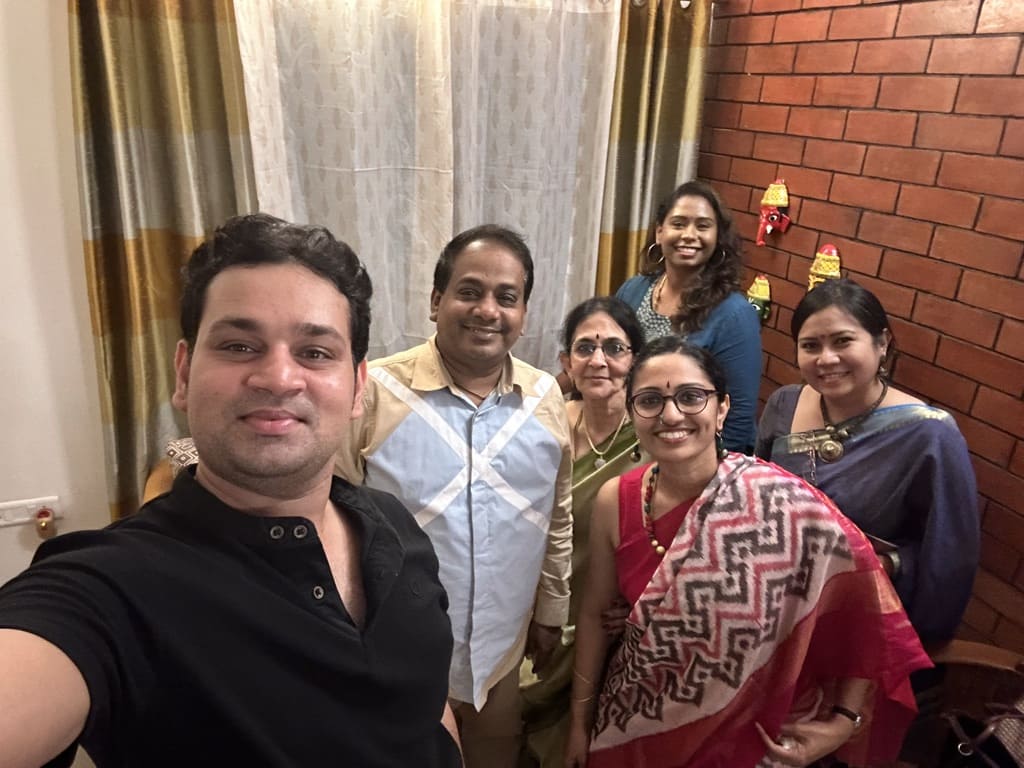
Spirit of Margazhi Bharatanatyam dancer Nitya Sriram from Singapore recounts her experience of the December Music Dance season 2022-2023; her learnings, new perspectives and connecting with the dance community from across the world in Chennai The company dancers and I had excitedly gone through the Music Academy schedule multiple times, prior to the trip and had almost memorized it. We chatted away on the flight to Chennai, discussing the exciting line-up of the Madras Music Academy Dance Festival. This time, we at Apsaras Arts, had the lovely opportunity of dancing at two prestigious venues in Chennai at Vani Mahal on 5 January and the prestigious Madras Music Academy on 8 January. The dance festival line-up at the Music Academy was, as always, amazing. Every solo artiste had something unique to bring to the festival. Bharatanatyam dancer Praveen Kumar kickstarted the festival with a phenomenal solo. He performed the piece, Yathai Kandu Nee Ichai Kondai, in ragam Kalyani which I will never forget. This Padam was narrated from the perspective of a father and is about dealing with his relationship with his daughter, and was different from the typical Padams that we usually learn. Every artiste incorporated a piece of themselves into their dancing and there was a lot of divergence from traditional topics that were covered in their repertoire. It was truly refreshing to watch and spurred some creative ideas in me as well. Apart from the slew of performances, we had rehearsals every day. We got the opportunity to re-unite with our friends from India. It was fantastic to spend time with Rutuja, Nivedha and Vaishnavi who danced with us just a couple of months ago at Esplanade Theatres for ARISI:Rice. We immediately got to syncing our learning with theirs and had a fabulous time dancing with them on stage in their home ground. Vani Mahal and Music Academy are venues I have frequented since I was a child and have seen so many of my dance idols perform here, and to be dancing on those very stages felt absolutely surreal to me. Connecting with other like-minded dancers, watching programmes and dancing everyday, made the trip wholesome. To be in a city with so much talent during the beautiful season of Margazhi will be an experience I will never forget.
Work-in-Process
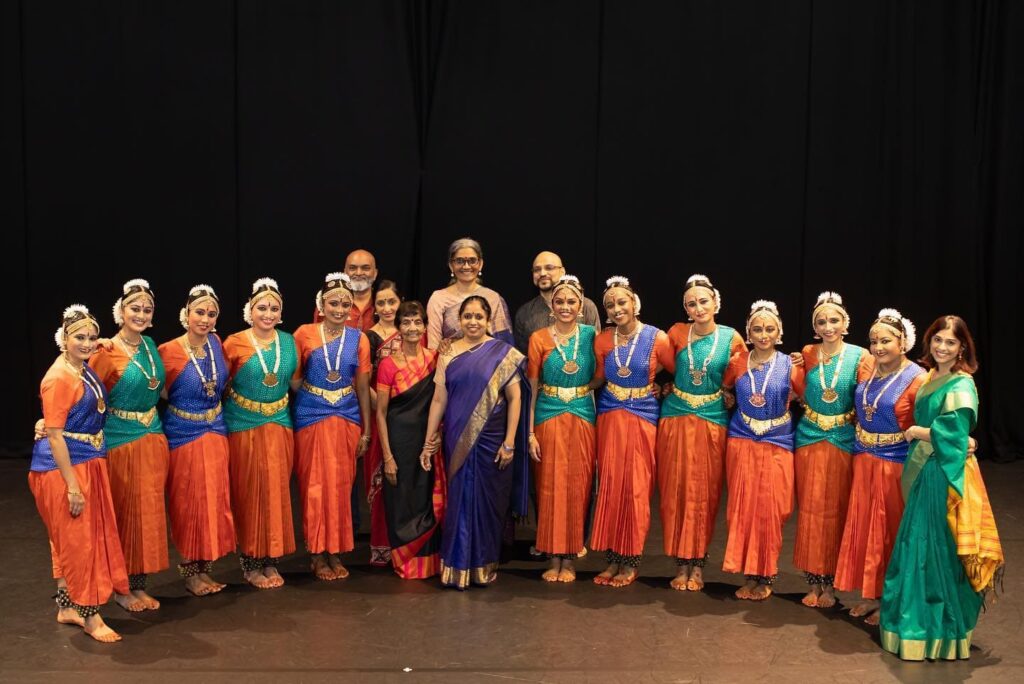
All Things Under the Sun Lakshmi Krishnan and Sujatha Rajagopalan, senior teachers from the Temple of Fine Arts, Singapore, jointly explore their new work Surya – An Awakening, with their fellow dancers. A sneak peek into the process behind the work Surya, your latest production, is a search, a seeking. What triggered this idea? It had been a long time since the full strength of our Bharatanatyam dancers had come together as one. Our dancers and students were all growing individually, one by one finishing their Arangetrams and continuing their learning journeys, training and explorations. But during the years of the pandemic there were many restrictions, and we couldn’t be together in the same space. That’s how Surya began – with a desire, an idea of wanting to be together in the same space and share the energy that comes with being together. In coming together, we experience warmth, energy and vigour. All the same things we receive from the sun. In Surya, the production, we awaken once again the spirit of moving together, getting things done with newfound ardour, sincerity, light and love. In most of your productions, there is a notion of seeking, of finding; why is this integral to your dance and to your journey as an artiste? I think the idea of seeking is fundamental to every student of the arts and to myself as a life-long student as well as a teacher to other students. The idea of seeking is also something that is very close to the Temple of Fine Arts, as well. Our Founder established the Temple of Fine Arts and set us on a journey to seek and share beauty, love, light, art just for the love of it. And it is never done alone. Yes, the seeker seeks, but there is always the sublime who helps to shine light on the path, to help us across to the other side of the river; whether it is providence or a teacher or the energy of the group that acts as our boatman. Surya is an idea dancers have dabbled with often. What sets this apart? And how? Ours is an inward journey through three items. Our search for the question of what the sun means to us happened during the process and it is interesting because the search and quest for answers has been a true one, and not just for the show. With Surya, we are trying to go deeper into the subject. Yes these are things we have done before or subject matters we have explored, but when we go deeper we also awaken our senses to new discoveries and revelations. Both for ourselves as choreographers and for our dancers who have different levels of experiences, who are all awakening to the nuances and depths of Bharatanatyam in different ways. Surya is a performance in Bharatanatyam inspired by the traditional solo margam repertoire structure, but explored through a group ensemble. It has been very fulfilling to work together with this group of young adults and dancers, to listen to their thoughts and see how the different imageries and meanings of lyrics have now unfolded. Take us through the process of how an idea translates into form and expression? Typically how long do you work on a production? A production takes a long time, from inception to bouncing around ideas, back and forth with storyboarding, music, and iterating through dance. It typically takes about a year. For Surya, most of the items had already been choreographed as solo pieces of work, and were completely re-looked and re-worked for 11 bodies to create so much more depth, imagery and meaning. We also had the challenge of working with 11 dancers at a time when the Temple of Fine Arts was moving its premises and there was a shuffle in rehearsal space availability. Our dancers worked closely with us, we worked closely with our dancers, and we are very proud of what we are sharing on stage in a few weeks to come. What about lighting, costume, etc. what role do they have to play? The lighting will serve to enhance the thought process of the dance and to also help bring out imagery and formations to elevate the experience. We have kept costumes simple but the colour schemes will go with the theme of Surya. Are your creations truly collaborative in nature? How does that elevate the whole process and experience? We are blessed to be working with a group of mature young dancers, who are encouraged to contribute ideas for group choreography. The safe space we have created for them has enabled them to actively be involved in giving suggestions to do different aspects of the choreography be it formations, imagery or even movement. In this way we have seen them actively grow over the past few months and it has been a rewarding experience for us, to say the least. We have collaborated with our musicians at the Temple of Fine Arts to also enhance the experience of music for the ensemble work. Our dancers have also taken interest in costuming, designing brochures and posters, publicity and marketing. We have allowed them this platform to grow by collaborating, to enter the space, to bring in their expertise in these areas. We are also working with a professional lighting designer. Having been a dancer himself and worked on several dance productions with us in the past, he serves to enhance the experience by understanding the choreography better. It is a gratifying experience for us to see our dancers being involved in the full process of the production, so that they are growing in a more holistic way as artistes.
Work-in-Process
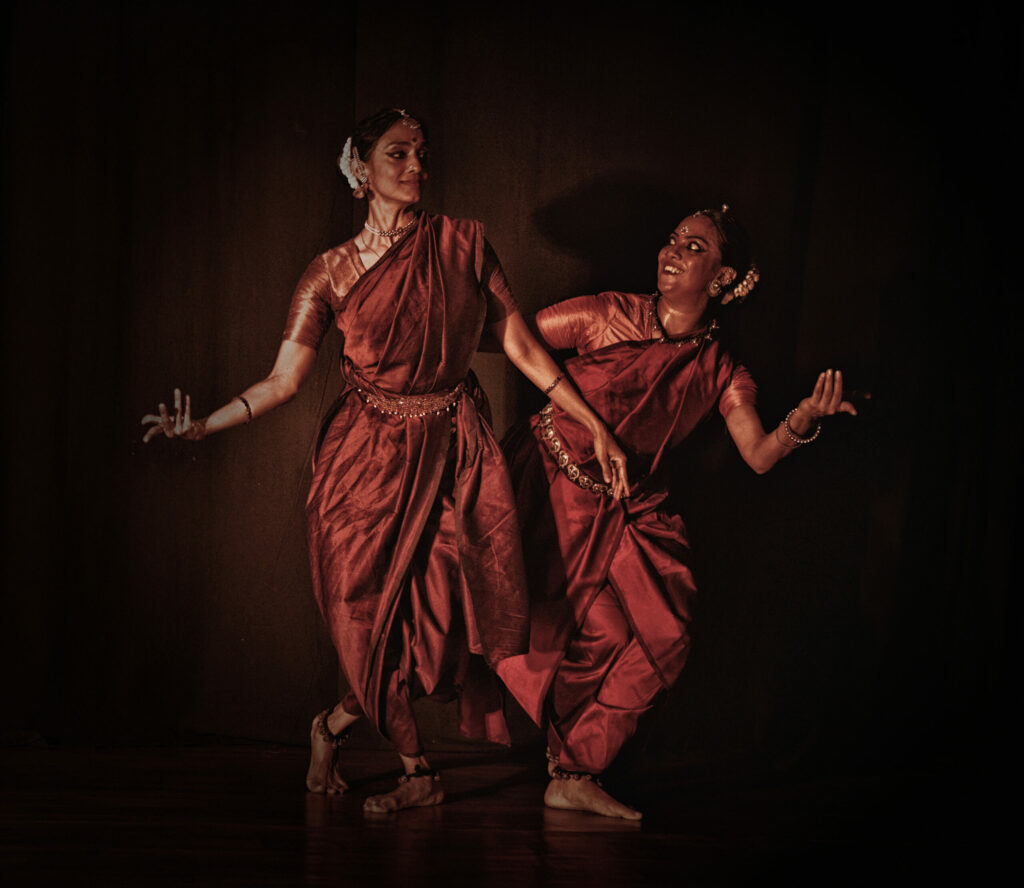
Ode to the Senses The classical styles of Odissi and Bharatanatyam, conceived and performed by artistes Shashwati Garai Ghosh and Lakshmi Parthasarathy Athreya, come together to create Anubhav, a sensory experience. Read on for how this work came to be in an interview that combines the voices of both artistes What is the genesis of Anubhav: Deeper with the Senses? It all started from a very honest friendship and vibe as thoughtful artistes. As solo artistes, how important is it to have a good working relationship both professionally and personally? Any art form requires a sense of collaboration. Though we call it a solo, it is honestly a lot of teamwork. As dancers we cannot create or present anything in isolation; we need a team with good work ethics, those who are committed to the project and are keen to maintain good relationships to keep the process going. What inspired the title Anubhav? We both are at a phase in our lives where we are keen to present and share our experiences and artistic ventures with a larger universe. Anubhav occurred in a very organic manner and fit itself beautifully into the form of a production that brings both our aesthetics and artistic sensibilities to the fore. We had the fortune of witnessing Anubhav in Chennai. Why is it essentially a sensory experience? Anubhav speaks a lot about deep and intense senses, both physical and emotional. You have already premiered the work in Chennai, Bangalore and Kolkata. Is the work evolving as it travels across cities and what are the key takeaways from it? Absolutely! Dancing as duets, with two different classical dance forms has been challenging and at the same time, a very welcoming experience. To remain in our respective genres but also intertwine with each other’s sensibilities and create one vibe has been a real learning process. Anubhav will grow and mature with our artistic growth. Also it will remain open to creative changes so that it evolves more.
Books Banter
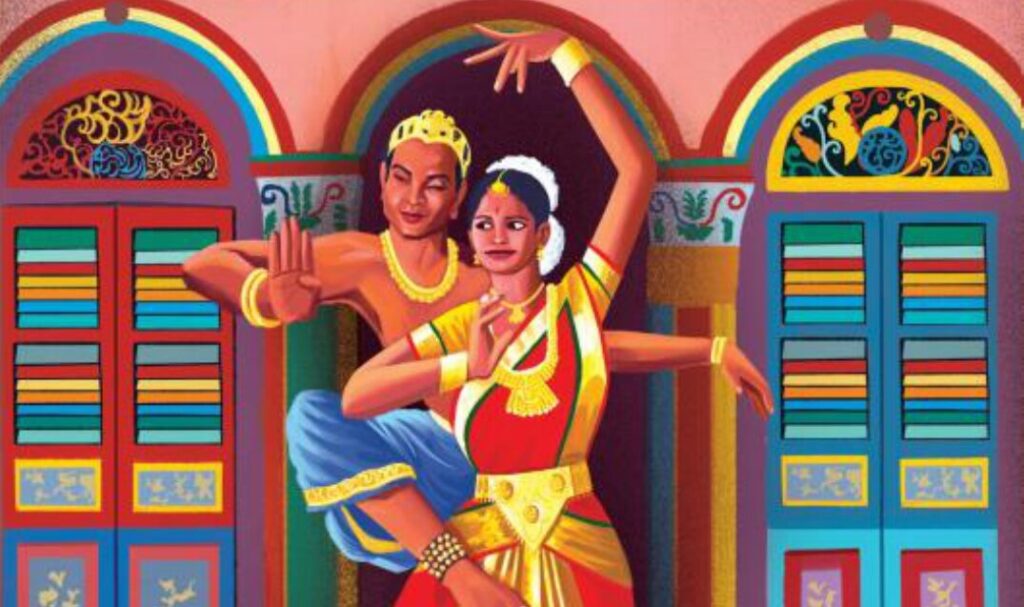
Sketch in Time Meenakshi Bhaskar, Artistic Director, Bhaskar’s Arts Academy, Singapore, talks to us about their new comic book, designed specifically as a tribute to their Founders, KP Bhaskar and Santha Bhaskar. How did the idea of this book come up? Various ideas were explored to commemorate Bhaskar’s Arts Academy’s (BAA) 70th anniversary in 2022. One of them was to create a book that would celebrate and tell the story of our founders, KP Bhaskar and Santha Bhaskar. The BAA team wanted an easy-to-read book that would appeal to all age groups and therefore the Amar Chitra Katha style was chosen. BAA then reached out to local children’s author Abhirami Krishnasamy to take on the project, who by chance was already planning to write a book on Mr & Mrs Bhaskar, her teachers. Things quickly fell into place after that. Abhirami introduced us to illustrator Sayan Mukherjee and publisher World Scientific Publishing. Why did you choose to go the illustration way? Children of Indian descent have learnt about mythology, fables and even Indian historical figures from a comic series called Amar Chitra Katha. These books conveyed the story in an easy-to-read manner and were a popular way to introduce children to the stories from their culture. We wanted a book that would be accessible to as many people as possible. The actual story of how Mr Bhaskar had his start in the arts is dramatic, as is the story of how he chose and married Mrs Bhaskar. This is the story of a pioneer of dance in Singapore, and of a South Asian migrant, which is still relevant in so many ways. The vibrant and colorful depictions convey the story in a novel way, and allows readers to finish it in one sitting. Who is the book meant for? The book was written so that even young children could be engaged by the story. We wanted to reach all demographics. The extraordinary life of Mr & Mrs Bhaskar is inspiring, considering their humble beginnings. They never gave up even during tough times. We believe it is a story that needs to be captured and preserved for future generations, and hope it can serve to inspire the many emerging artists around the globe. What can we expect from the book? Is it a biography on the lives of KP Bhaskar and Santha Bhaskar through the lens of dance? This is a story of KP Bhaskar and Santha Bhaskar, pioneers of dance in Singapore. It is also the story of South Indian migrants to Singapore, and how they started up. It is a story of the beginnings of a couple who strove hard to keep arts alive in Singapore through all the odds they faced.